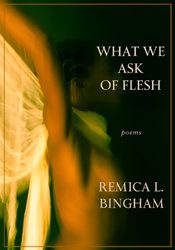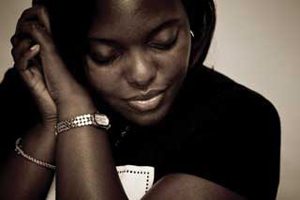
These days a book can now be whatever it wants to be. Genres blend and styles overlap, creating sometimes works impossible to label. And while the market is saturated with narratives that claim to be one thing while aspiring to be another and still end up being something else entirely, the intense and careful art of poetry—in all of its freedoms—has always been understood to possess this blending, this overlap. Poetry can always be whatever it wants to be, with few limitations, like dressing up for Halloween. This is how I realized Remica L. Bingham’s startling book of poems, What We Ask of Flesh.
To begin reading poems by an author I’ve not encountered before I ordinarily follow an obsessive-compulsive ritual: I look at the front cover, read the back matter, assess the cover again, open and read end notes and then the front acknowledgments and introduction, let it sink in for a while, then proceed. With What We Ask of Flesh. I jumped in and read the 12-section “The Body Speaks” before visiting the notes, reading them again and then the whole book. I recommend all the notes first unless you, like I do, prefer spending a lot of time with a poetry book and experiencing it uninformed and then, later, a different sort of enlightened. Until a house fire it’s mine for the long haul, so there’s no need to hurry.
“The Body Speaks” is a product of study and draws from the Bible, a Science News article, Alice Walker and then an extensive list of authors: section 11 of the book’s opening piece consists mostly of lines from poems and works written by Atwood, Clifton, Kumin, Trethewey and many more. A large and stretching beginning, the poem speaks to specific things as almost a series of notes, calling for its study as well. In some areas it reads traditionally(even if a typo appears present):
This is the worse kind of love story. Lov-
ing a thing to death, loving a thing until it
strangles you.
And then there are other moments, like the end of section 5 where not much seems resolved, leading to the notion that perhaps nothing is supposed to be:
They
splay calves under brush
fight to fill
hollow they scrape they rip
they scourge they grip
say open gape thighs
then
break them clean
The section seems to only exist as part of the larger poem, but it could stand free perhaps at risk of losing much context and meaning. But “The Body Speaks” needs all of itself to be the conversation piece it is. Unconventional and varied, it is gifted yet difficult and a bold move to keep as the book’s opening.
The first poem of the second part of the book is called “Things I Carried Coming Into The World.” I read it several times in fear I was reacting too positively to it because of the prior density of What We Ask of Flesh.. But the poem is perfection. It marries the title effortlessly like air and dust, but the body of the piece is not simple. It invokes memory, shades of family and guilt, injustice and silence, items of reality and confusion. Moments in the poems such as
the cleft a loss in 1967 creates
when a mother of mine
two mothers removed
is left broken on the sidewalk
after a drunk white man
jumps the curb
in the colored neighborhood,
and
a fistful of wanting; foreign bodies
wandering through my own;
a blow to the insides when distance
walks in; the braid of death,
created in me unsettled feelings of loss, lists of gone things removed before I could understand them. But I was reading these things as my own though they were not, and by becoming the voice I was lost as Reader, a true sign of graceful power as an end product of Bingham’s generosity.

“What We Ask of Flesh” is the title piece in the second part of the book and the fourth poem of what appears in the table of contents to be a collection of eleven poems. This is a lengthy poem like the first, comprised of multiple parts demonstrating what’s mentioned early on as part of what poetry can be—whatever it wants to be. Part IV of this poem is stellar and should be read several times. Her ability to tell story, remain in two forms of stanzas, and to generate such emotional affect is staggering here.
In the ruins, voices are one long-strung note:
you hear the doctor
Third degree severe ongoing traumathen your grandmother, tending
Let it breathe awhile
don’t wrap the skin so tightand
I remember you there, then the ambulance
you pray on this
recalling a lesson about sin:
we are almost punishment enough for ourselves.
The real intensity of this collection seems to have been generated from its core. Part I builds, displaying craft and ability and targets matter-of-factly the reality of woman-ness I almost found myself envying. Part II is all power and horror and grit and honesty and honor. I will remember for a long time where I sat and what I was doing when I read the central thrust of What We Ask of Flesh. Part III nearly exhales back from the rest of the text, seeming weary but not out of focus, five poems spreading across twenty pages that keep with the long poem/multiple section trend and discuss less severe topics of progressing through life but with a sharpness that more or less replaces the earlier intensity. In “House of the Ten Plagues”, this is the entirety of section 8:
Countless bodies in the tub
don’t drown and won’t be caught.
The exterminator calls them large outdoor roaches,
this is their breeding ground: low house,
over the sewer drain, vacant for years.
No matter how clean you’ve been
he says, spraying poison behind the mirror,
under the sink, on the bleached baseboards,
as long as you’re on earth
they’ll find a way in.
This type of drive toward finale gives the book another dimension of accessibility for readers likely weary as well, from how astutely Remica L. Bingham captures, yes, body and soul in What We Ask of Flesh.. What impresses me about the conclusion is that she gives us time to finish it and not be surprised after much concern to discover that she is fine. She becomes (or remains) her “blinding self: black bird singing: home, free.”




